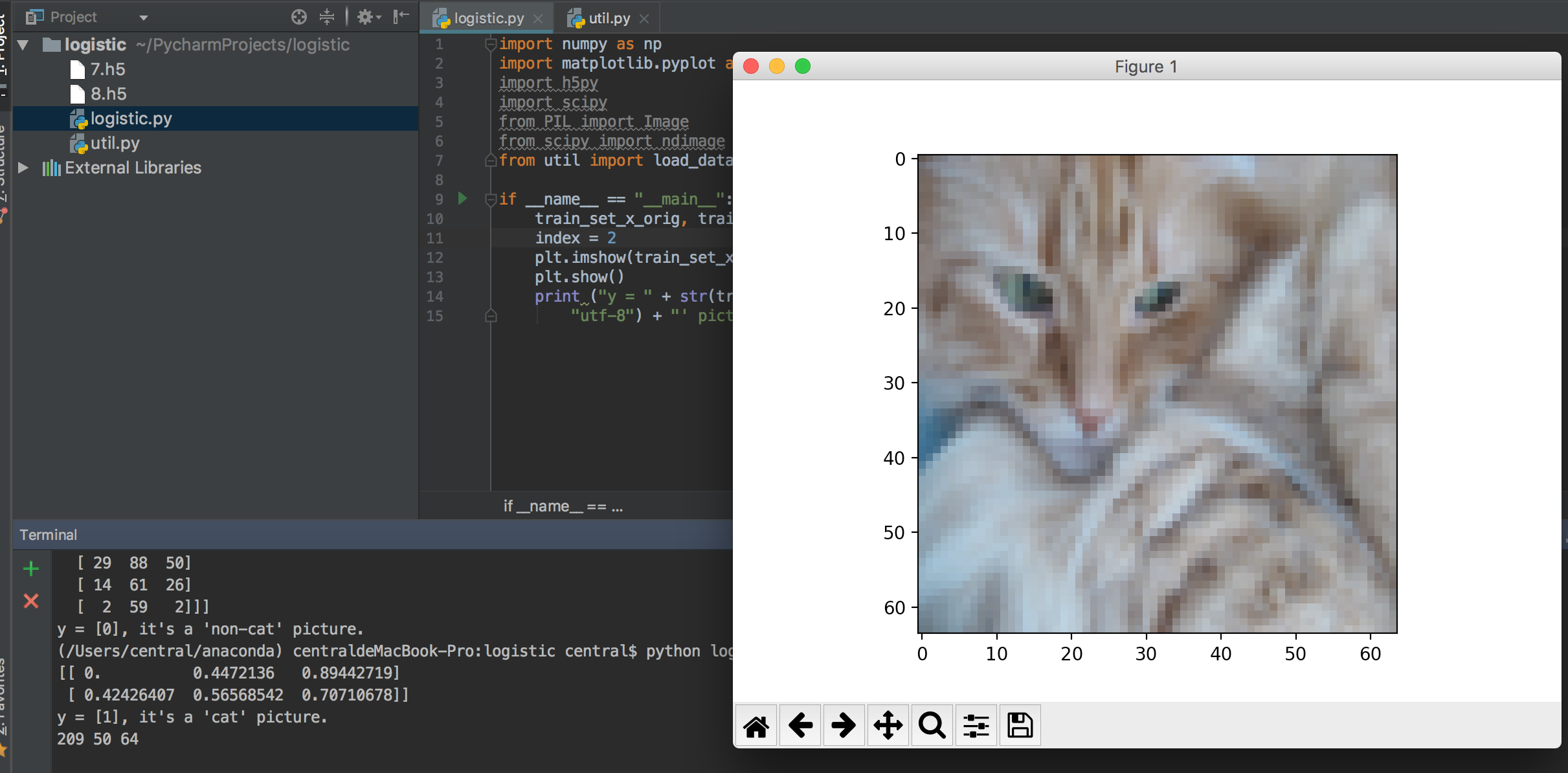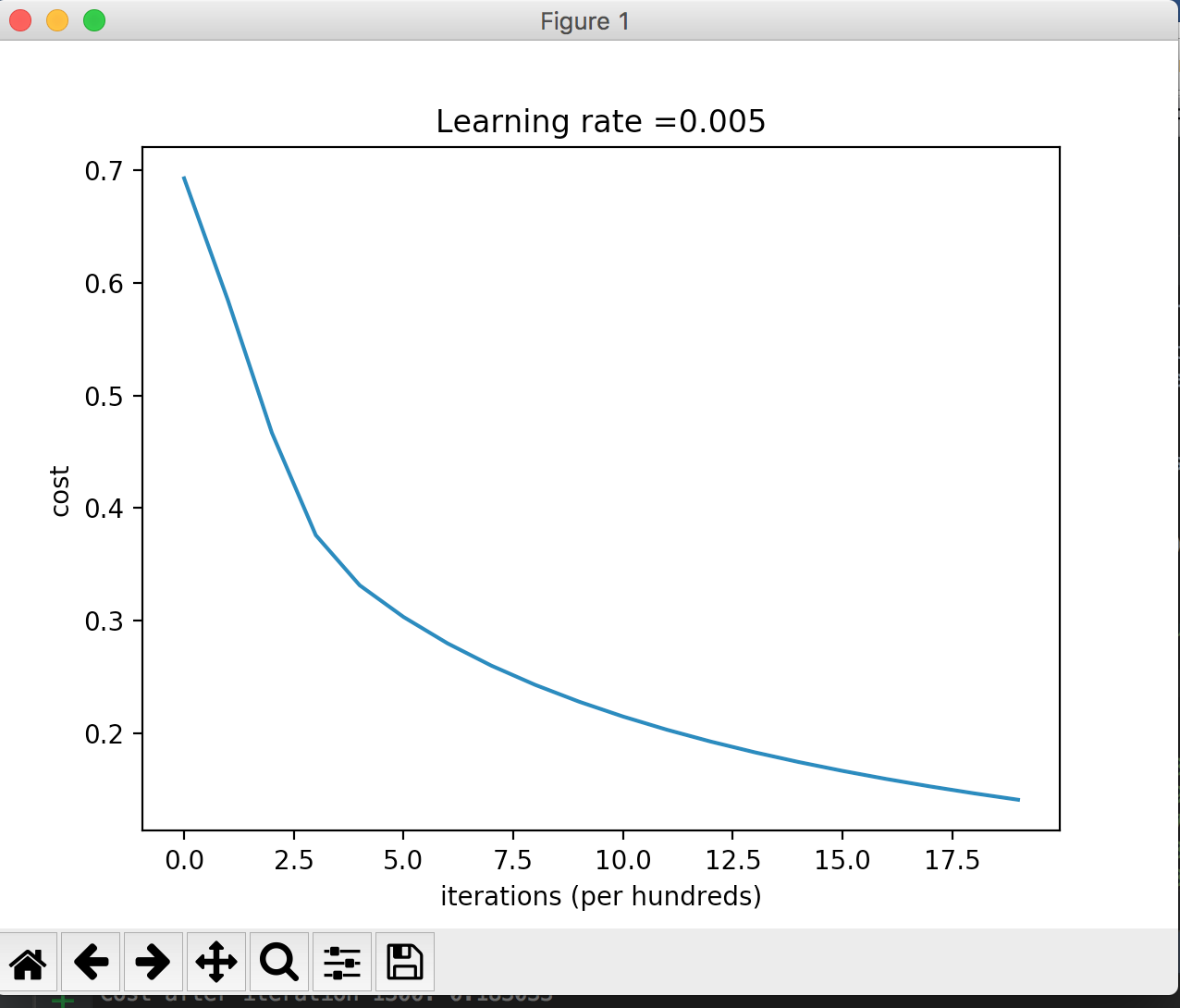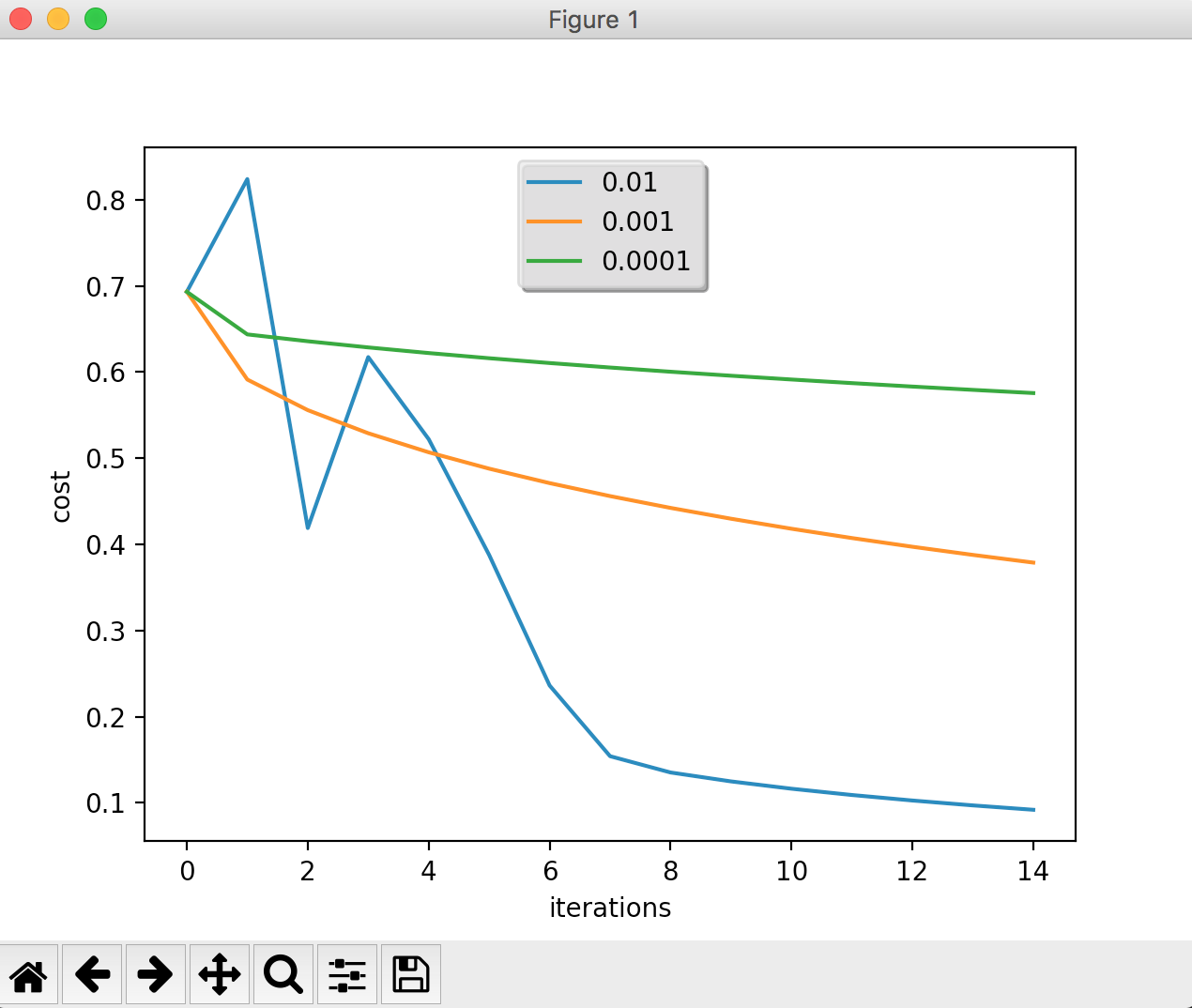实现一个sigmoid函数
import numpy as np
def sigmoid(x):
"""
使用numpy,可支持矢量计算
sigmod函数,可用于矢量和矩阵
"""
s = 1.0 / (1 + 1 / np.exp(x))
return s
x = np.array([1, 2, 3])
print (sigmoid(x))
"""
[ 0.73105858 0.88079708 0.95257413]
"""计算sigmod函数的导数
def sigmoid_derivative(x):
s = 1.0 / (1 + 1 / np.exp(x))
ds = s*(1-s)
return ds在训练之前,首先需要读取数据,读取数据的代码如下:
def load_dataset():
"""
加载数据集
7.h5为训练集,8.h5为测试集
"""
train_dataset = h5py.File('/Users/central/PycharmProjects/logistic/7.h5', "r") # 读取H5文件
train_set_x_orig = np.array(train_dataset["train_set_x"][:]) # your train set features
train_set_y_orig = np.array(train_dataset["train_set_y"][:]) # your train set labels
test_dataset = h5py.File('/Users/central/PycharmProjects/logistic/8.h5', "r")
test_set_x_orig = np.array(test_dataset["test_set_x"][:]) # your test set features
test_set_y_orig = np.array(test_dataset["test_set_y"][:]) #
classes = np.array(test_dataset["list_classes"][:]) # [b'non-cat' b'cat']
train_set_y_orig = train_set_y_orig.reshape((1, train_set_y_orig.shape[0])) # 对训练集和测试集标签进行reshape
test_set_y_orig = test_set_y_orig.reshape((1, test_set_y_orig.shape[0]))
return train_set_x_orig, train_set_y_orig, test_set_x_orig, test_set_y_orig, classes
数据说明:
对于训练集的标签而言,对于猫,标记为1,否则标记为0。
每一个图像的维度都是(num_px, num_px, 3),其中,长宽相同,3表示是RGB图像。
train_set_x_orig和test_set_x_orig中,包含_orig是由于我们稍候需要对图像进行预处理,预处理后的变量将会命名为train_set_x和train_set_y。
train_set_x_orig中的每一个元素对于这一副图像,我们可以用如下代码将图像显示出来:
if __name__ == "__main__":
train_set_x_orig, train_set_y, test_set_x_orig, test_set_y, classes = load_dataset();
index = 2
plt.imshow(train_set_x_orig[index])
plt.show()
print ("y = " + str(train_set_y[:, index]) + ", it's a '" + classes[np.squeeze(train_set_y[:, index])].decode(
"utf-8") + "' picture.")
"""
y = [1], it's a 'cat' picture.
"""
接下来,我们需要根据图像集来计算出训练集的大小、测试集的大小以及图片的大小:
if __name__ == "__main__":
train_set_x_orig, train_set_y, test_set_x_orig, test_set_y, classes = load_dataset();
m_train = train_set_x_orig.shape[0]
m_test = test_set_x_orig.shape[0]
num_px = train_set_x_orig.shape[1]
print(m_train, m_test, num_px)
"""
209 50 64
"""训练集大小为209,测试集为50,图片的大小为64*64.
接下来,我们需要对将每幅图像转为一个矢量,即矩阵的一列。
最终,整个训练集和测试集将会转为一个矩阵,其中包括num_px*numpy*3行,m_train列。
train_set_x_flatten = train_set_x_orig.reshape(train_set_x_orig.shape[0], -1).T
test_set_x_flatten = test_set_x_orig.reshape(test_set_x_orig.shape[0], -1).T其中X_flatten = X.reshape(X.shape[0], -1).T可以将一个维度为(a,b,c,d)的矩阵转换为一个维度为(b∗∗c∗∗d, a)的矩阵。
接下来,我们需要对图像值进行归一化。
由于图像的原始值在0到255之间,最简单的方式是直接除以255即可。
train_set_x = train_set_x_flatten/255.
test_set_x = test_set_x_flatten/255.接下来,我们将按照如下步骤来实现Logistic:
1. 定义模型结构
2. 初始化模型参数
3. 循环
3.1 前向传播
3.2 反向传递
3.3 更新参数
4. 整合成为一个完整的模型
初始化w,b
def init_params(dim):
#初始化w为dim行,1列的矩阵
w = np.zeros((dim, 1))
b = 0
return w, b前向传播与反向传播
def propagate(w, b, X, Y):
#一共有m个训练集
m = X.shape[1]
#前向传播
A = sigmoid(np.dot(w.T, X)+b)
#代价函数
cost = -1.0 / m * np.sum(Y * np.log(A) + (1.0 - Y) * np.log(1.0 - A))
#反向传播
dw = 1.0 / m * np.dot(X, (A-Y).T)
db = 1.0 /m * np.sum(A - Y)
#删除单维数据
cost = np.squeeze(cost)
#梯度
grads = {
"dw": dw,
"db": db
}
return cost, grads更新参数
def upgrade_params(w, b, X, Y, num_iterations, learning_rate, print_cost = False):
costs = []
#迭代循环
for i in range(num_iterations):
cost, grads = propagate(w, b, X, Y)
dw = grads["dw"]
db = grads["db"]
#更新w,b
w = w - learning_rate * dw
b = b - learning_rate * db
if i%100 ==0:
costs.append(cost)
if print_cost and i % 100 == 0:
print("Cost after iteration %i: %f" % (i, cost))
params = {"w": w, "b": b}
grads = {"dw": dw, "db": db}
return params, grads, costs
使用测试集去预测模型:
def predict(w, b, X):
m = X.shape[1]
Y_predict = np.zeros((1, m))
w = w.reshape(X.shape[0], 1)
A = sigmoid(np.dot(w.T, X) + b)
for i in range(A.shape[1]):
if A[0][i] > 0.5
Y_predict[0][i] = 1
else:
Y_predict[0][i] = 0
return Y_predict整合为一个模块:
def model(X_train, Y_train, X_test, Y_test, num_iterations=2000, learning_rate=0.5, print_cost=False):
#将w,b参数初始化为0
w, b = init_params(X_train.shape[0])
#更新优化参数
parameters, grads, costs = upgrade_params(w, b, X_train, Y_train, num_iterations, learning_rate, print_cost)
w = parameters["w"]
b = parameters["b"]
#预测测试集和训练集
Y_prediction_test = predict(w, b, X_test)
Y_prediction_train = predict(w, b, X_train)
# Print train/test Errors
print("train accuracy: {} %".format(100 - np.mean(np.abs(Y_prediction_train - Y_train)) * 100))
print("test accuracy: {} %".format(100 - np.mean(np.abs(Y_prediction_test - Y_test)) * 100))
d = {"costs": costs,
"Y_prediction_test": Y_prediction_test,
"Y_prediction_train": Y_prediction_train,
"w": w,
"b": b,
"learning_rate": learning_rate,
"num_iterations": num_iterations}
return d我们最终来测试一下该模型:
if __name__ == "__main__":
train_set_x_orig, train_set_y, test_set_x_orig, test_set_y, classes = load_dataset();
train_set_x_flatten = train_set_x_orig.reshape(train_set_x_orig.shape[0], -1).T
test_set_x_flatten = test_set_x_orig.reshape(test_set_x_orig.shape[0], -1).T
#归一化处理图像集
train_set_x = train_set_x_flatten / 255.
test_set_x = test_set_x_flatten / 255.
#迭代2000次,学习速率为0.005
d = model(train_set_x, train_set_y, test_set_x, test_set_y, num_iterations=2000, learning_rate=0.005,
print_cost=True)
"""
Cost after iteration 0: 0.693147
Cost after iteration 100: 0.584508
Cost after iteration 200: 0.466949
Cost after iteration 300: 0.376007
Cost after iteration 400: 0.331463
Cost after iteration 500: 0.303273
Cost after iteration 600: 0.279880
Cost after iteration 700: 0.260042
Cost after iteration 800: 0.242941
Cost after iteration 900: 0.228004
Cost after iteration 1000: 0.214820
Cost after iteration 1100: 0.203078
Cost after iteration 1200: 0.192544
Cost after iteration 1300: 0.183033
Cost after iteration 1400: 0.174399
Cost after iteration 1500: 0.166521
Cost after iteration 1600: 0.159305
Cost after iteration 1700: 0.152667
Cost after iteration 1800: 0.146542
Cost after iteration 1900: 0.140872
train accuracy: 99.04306220095694 %
test accuracy: 70.0 %
"""此时,观察打印结果,我们可以发现我们的测试集准确率已经可以达到70.0%。而对于训练集,其准确性达到了99%。这表明了我们的模型有着一定的过拟合,我们会在后续的内容中来解决这一问题。
我们也可以画出代价函数的曲线:
costs = np.squeeze(d['costs'])
plt.plot(costs)
plt.ylabel('cost')
plt.xlabel('iterations (per hundreds)')
plt.title("Learning rate =" + str(d["learning_rate"]))
plt.show()
之前的理论课程中,我们已经提及过学习速率对于最终的结果有着较大影响,现在,我们来用实验让大家有一个直观的了解。
train_set_x_orig, train_set_y, test_set_x_orig, test_set_y, classes = load_dataset();
train_set_x_flatten = train_set_x_orig.reshape(train_set_x_orig.shape[0], -1).T
test_set_x_flatten = test_set_x_orig.reshape(test_set_x_orig.shape[0], -1).T
# 归一化处理图像集
train_set_x = train_set_x_flatten / 255.
test_set_x = test_set_x_flatten / 255.
learning_rates = [0.01, 0.001, 0.0001]
models = {}
for i in learning_rates:
print("learning rate is: " + str(i))
models[str(i)] = model(train_set_x, train_set_y, test_set_x, test_set_y, num_iterations=1500, learning_rate=i,
print_cost=False)
print('\n' + "-------------------------------------------------------" + '\n')
for i in learning_rates:
plt.plot(np.squeeze(models[str(i)]["costs"]), label=str(models[str(i)]["learning_rate"]))
plt.ylabel('cost')
plt.xlabel('iterations')
legend = plt.legend(loc='upper center', shadow=True)
frame = legend.get_frame()
frame.set_facecolor('0.90')
plt.show()
从图中结果反映出不同的学习速率会导致不同的预测结果。较小的学习速度收敛速度较慢,而过大的学习速度可能导致震荡或无法收敛。
如果想用自己的图像做测试,可已使用以下代码:
my_image = "cat2.jpg" # change this to the name of your image file
## END CODE HERE ##
# We preprocess the image to fit your algorithm.
train_set_x_orig, train_set_y, test_set_x_orig, test_set_y, classes = load_dataset();
train_set_x_flatten = train_set_x_orig.reshape(train_set_x_orig.shape[0], -1).T
test_set_x_flatten = test_set_x_orig.reshape(test_set_x_orig.shape[0], -1).T
# 归一化处理图像集
train_set_x = train_set_x_flatten / 255.
test_set_x = test_set_x_flatten / 255.
num_px= 64;
fname = "picture/" + my_image
image = np.array(ndimage.imread(fname, flatten=False)) # 读取图片
my_image = scipy.misc.imresize(image, size=(num_px, num_px)).reshape((1, num_px * num_px * 3)).T # 放缩图像
d = model(train_set_x, train_set_y, test_set_x, test_set_y, num_iterations=2000, learning_rate=0.005,
print_cost=True)
my_predicted_image = predict(d["w"], d["b"], my_image) # 预测
plt.imshow(image)
print("y = " + str(np.squeeze(my_predicted_image)) + ", your algorithm predicts a \"" + classes[
int(np.squeeze(my_predicted_image)),].decode("utf-8") + "\" picture.")
注:
之前我的训练样本都是在64*64的样本进行测试,所以使用自己的测试图片时,如果图像像素过大,可能出现预期结果很差的现象,所以我们在测试时可以选择图像像素较小的进行测试。
关于基础算法部分,可以参考:https://my.oschina.net/CentralD/blog/1541585






















 367
367

 被折叠的 条评论
为什么被折叠?
被折叠的 条评论
为什么被折叠?








